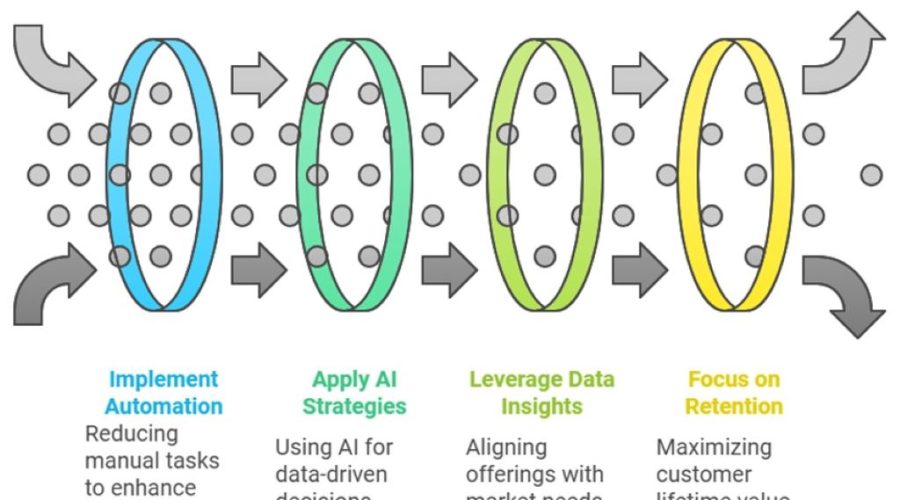Scaling a SaaS business is no small feat. It requires strategic planning, relentless execution, and an unwavering focus on customer satisfaction. In today’s hyper-competitive market, businesses that fail to scale effectively risk being left behind. But what does it take to grow your SaaS company sustainably? How to scale a SaaS business involves balancing rapid expansion with maintaining quality and profitability. This comprehensive guide will walk you through the ins and outs of scaling a SaaS business, offering actionable insights, expert opinions, and real-world examples to help you achieve explosive growth.
The Importance of Scaling Your SaaS Business
Before diving into the “how,” let’s first address the “why.” Why is scaling so critical for SaaS businesses? Unlike traditional businesses, SaaS companies operate on subscription-based models, which means recurring revenue is king. However, this also means that churn (customer attrition) can be a silent killer. According to a report by ProfitWell, reducing churn by just 5% can increase profits by up to 125%. Scaling isn’t just about acquiring new customers; it’s about retaining existing ones while expanding your reach.
Why Scaling Matters
- Revenue Growth : Scaling allows you to tap into new markets, upsell to existing customers, and maximize lifetime value.
- Operational Efficiency : As you scale, processes become more streamlined, reducing costs per acquisition and improving margins.
- Competitive Advantage : A scalable SaaS business can outpace competitors by leveraging technology and automation.
Laying the Foundation: Preparing for Scalability
Before you can scale, you need a solid foundation. Without one, any attempt at growth will crumble under pressure. Here’s how to prepare your SaaS business for scalability:
-
Build a Scalable Product
Your product must be designed with scalability in mind. This means:
- Cloud Infrastructure : Use platforms like AWS or Azure to ensure your product can handle increased traffic without downtime.
- Modular Architecture : Break your software into smaller, independent modules that can be updated or scaled individually.
According to a McKinsey study, companies that invest in cloud infrastructure see a 20% faster time-to-market compared to those relying on legacy systems.
-
Focus on Customer Success
Happy customers are the backbone of any successful SaaS business. Invest in:
- Onboarding Programs : Ensure users understand how to get the most out of your product from day one.
- Proactive Support : Use AI-driven chatbots and human agents to resolve issues before they escalate.
HubSpot’s research shows that businesses with strong customer success programs experience 33% higher retention rates.
-
Develop a Data-Driven Culture
Data should guide every decision you make. Implement tools like Google Analytics, Mixpanel, or Amplitude to track user behavior, identify bottlenecks, and optimize performance.
Strategies for Scaling Your SaaS Business

Now that your foundation is set, it’s time to implement strategies that drive growth. Below are proven methods to scale your SaaS business effectively.
-
Expand Your Market Reach
One of the quickest ways to scale is by entering new markets. Consider:
- Geographic Expansion : Localize your product for international audiences. For example, Slack grew its user base significantly by targeting European markets.
- Niche Segmentation : Identify underserved niches within your industry and tailor your offerings to meet their specific needs.
A Harvard Business Review article highlights that companies focusing on niche markets often achieve 2x faster growth than those pursuing broad appeal.
-
Leverage Partnerships and Integrations
Partnerships can supercharge your growth. Collaborate with complementary SaaS providers to create bundled solutions. For instance, Zapier integrates with over 5,000 apps, making it indispensable for users who rely on multiple tools.
-
Optimize Pricing Models
Pricing is both an art and a science. Experiment with tiered pricing, freemium models, and usage-based billing to find what works best for your audience. OpenView Partners found that SaaS companies using value-based pricing grow 20% faster than those using cost-plus models.
-
Automate and Streamline Operations
Automation is key to scaling efficiently. Tools like Zapier, HubSpot, and Salesforce can automate repetitive tasks, freeing up resources for innovation. Gartner predicts that by 2025, 70% of all customer interactions will involve machine learning applications.
Overcoming Common Challenges in Scaling
Scaling isn’t without its hurdles. Let’s explore some common challenges and how to overcome them.
Challenge #1: High Churn Rates
Churn is inevitable, but high churn can cripple your growth. Combat this by:
- Offering personalized experiences.
- Regularly gathering feedback and iterating on your product.
Challenge #2: Cash Flow Constraints
Scaling requires capital. Secure funding through venture capitalists, angel investors, or revenue-based financing if needed. CB Insights reports that 29% of startups fail due to running out of cash.
Challenge #3: Team Burnout
Rapid growth can strain your team. Foster a positive work culture and hire strategically to avoid burnout.
The Role of Technology in Scaling
Technology plays a pivotal role in scaling a SaaS business. From AI-powered analytics to advanced CRM systems, leveraging cutting-edge tech can give you a competitive edge.
AI and Machine Learning
AI can predict customer behavior, personalize marketing campaigns, and even automate customer support. Salesforce estimates that AI adoption in sales teams increases productivity by 50%.
Low-Code/No-Code Platforms
These platforms allow non-technical teams to build and deploy features quickly, accelerating innovation cycles.
Future Trends in SaaS Scaling
To stay ahead of the curve, keep an eye on emerging trends:
- Vertical SaaS : Industry-specific solutions are gaining traction as businesses seek tailored tools.
- Embedded Finance : Integrating financial services into SaaS products is becoming increasingly popular.
- Sustainability : Eco-friendly practices not only attract environmentally conscious customers but also reduce operational costs.
Frequently Asked Questions (FAQs)
-
What does it mean to scale a SaaS business?
Scaling involves growing your customer base, revenue, and operations without compromising quality or efficiency.
-
How long does it take to scale a SaaS business?
It varies depending on factors like market conditions, funding, and execution. On average, it takes 3-5 years to reach significant scale.
-
Is scaling the same as growth?
No. Growth refers to increasing metrics like revenue or users, while scaling focuses on sustainable expansion without proportional increases in costs.
-
What are the biggest risks when scaling a SaaS business?
High churn, cash flow issues, and team burnout are among the top risks.
-
Should I prioritize new customers or existing ones when scaling?
Both are important, but retaining existing customers typically yields higher ROI.
-
How important is branding in scaling a SaaS business?
Branding builds trust and recognition, which are crucial for attracting and retaining customers.
-
Can I scale my SaaS business without external funding?
Yes, but it may limit your speed and scope of growth.
-
What role does content marketing play in scaling?
Content marketing educates potential customers, builds authority, and drives organic traffic.
-
How do I know if my SaaS business is ready to scale?
Look for consistent revenue growth, low churn rates, and a scalable infrastructure.
-
What’s the most overlooked aspect of scaling a SaaS business?
Many overlook the importance of fostering a strong company culture during rapid growth.
Conclusion
Scaling a SaaS business is a complex yet rewarding journey. By laying a solid foundation, implementing proven strategies, and staying attuned to future trends, you can position your company for long-term success. Remember, scaling isn’t just about numbers—it’s about creating lasting value for your customers and stakeholders. So, roll up your sleeves, embrace the challenges, and watch your SaaS business soar to new heights.
Ready to take the next step? Start by auditing your current operations and identifying areas ripe for improvement. The future belongs to those who prepare for it today.
Read More:

